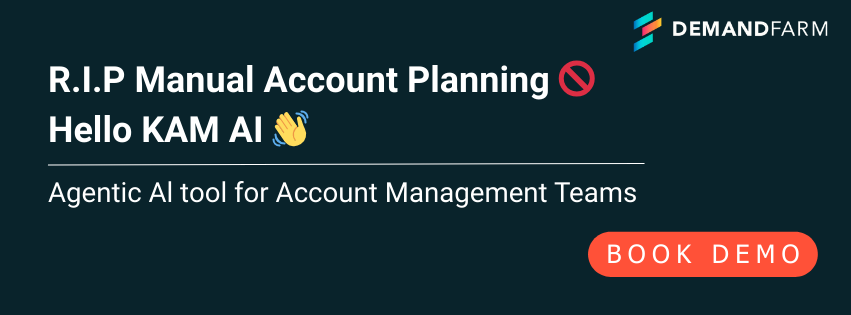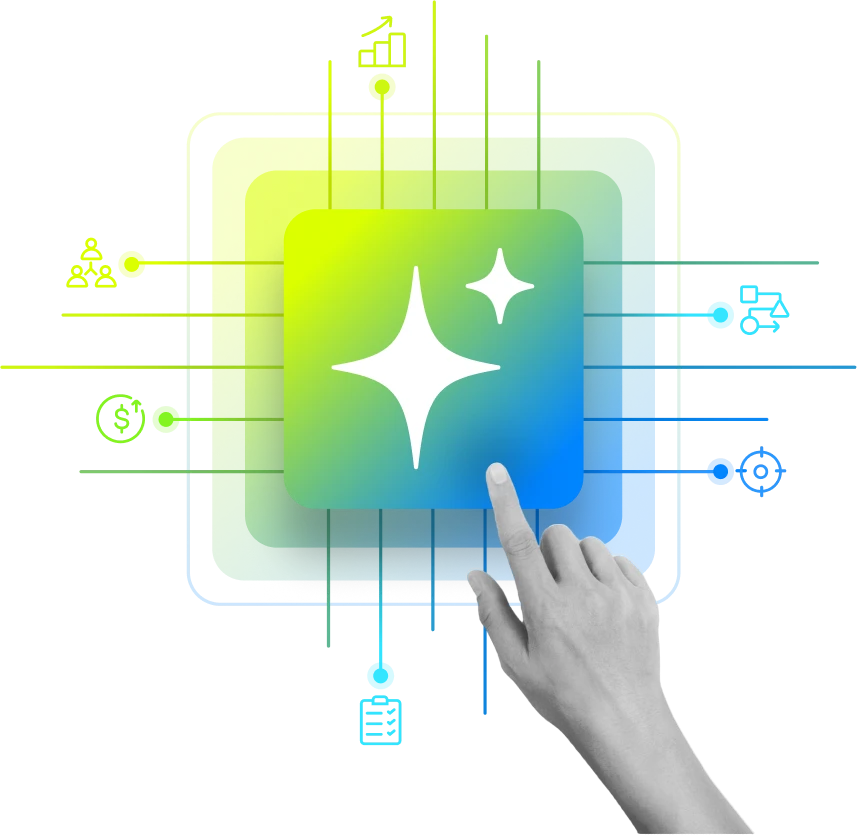In my years working alongside account management and customer success teams, one thing has become painfully clear: the Quarterly Business Review (QBR) process is broken.
Traditional QBRs demand hours of manual effort, juggling multiple systems, and aligning narratives, only to end up with a static presentation that barely scratches the surface of customer insights. The need for speed, clarity, and strategic relevance has never been more urgent.
That’s why I believe the era of AI Quarterly Business Review is here. Fueled by AI Quarterly Business Review Software and key account management tools (like DemandFarm), this transformation is helping teams transition from outdated reporting rituals to dynamic, data-driven storytelling.
Whether we call it an AI-Based QBR, a Generative AI EBR Solution, or simply “the smarter way to do reviews,” one thing is certain that there is no need for key account managers to do the heavy lifting.
Now, let’s dive into how exactly AI is revolutionizing quarterly reviews changing the facet of QBRs.
Why Traditional QBRs Are a Bottleneck
Let’s call it what it is! Traditional QBRs are hard.
Sifting through CRM exports, spreadsheets, emails, call transcripts, and dashboards just to build a slide deck manually… (you know what I am talking about). You’re spending your time on low-value work. Multiply that effort across multiple accounts, and it quickly becomes clear why QBRs are often deprioritized or delayed altogether.
According to McKinsey, 60% of work hours are spent on data collection and preparation rather than analysis and action. That’s exactly where AI comes in.
That’s time that should be spent on strategic thinking, customer conversations, or true expansion efforts.
Even when they’re completed, traditional QBRs suffer from:
- Data overload: Too many metrics, too little context.
- Inconsistent narratives: Different CSMs, different styles, different messages.
- Outdated information: Lag between data extraction and final review.
- Low engagement: Slides that speak “at” stakeholders, not “with” them.
And when it’s time for your Executive Business Review (EBR)? The stakes are even higher, and the problems multiply.
AI for QBRs and EBRs: Top Use Cases That Work
This is where AI for QBR EBR processes comes in to help teams work smarter. Let’s unpack the most valuable use cases we’re seeing across high-performing Customer Success and Account Management teams:
1. Automated Summary Generation
Instead of combing through metrics and typing up paragraphs of insights, AI tools can auto-generate summaries based on real-time performance data. It can detect patterns like revenue growth, product usage dips, or ticket escalation frequency, and write context-aware takeaways for your slides. I’d say it helps you make better sense of the account data you have.
2. Sentiment Analysis and Account Health
Advanced AI tools analyze customer sentiment from call transcripts, survey feedback, support tickets, and even email threads. This helps teams track evolving account sentiment and flag early warning signs. For example, a spike in negative sentiment combined with lower usage might trigger an alert even before a formal escalation.
This transforms your QBR from retrospective reporting into predictive intelligence.
3. Auto-Generated, QBR-Ready Slide Decks
Using integrated features within platforms like DemandFarm, you can upload reports, input context, and generate custom slides that adhere to brand guidelines and tell the right story, automatically.
Want slides for ARR growth, NPS trends, product adoption, and expansion pipeline? You are covered!
4. Narrative Personalization
C-level stakeholders want strategic insights. Day-to-day champions want detailed next steps. AI helps you customize narratives for different audiences without rebuilding the deck from scratch. With smart prompts, the same deck can adapt its tone, visuals, and depth of detail depending on the reader or presenter.
5. Content Enrichment On Demand
Give your designer a break! AI can help you add competitive benchmarks, best-practice recommendations, or even inspiration from previous top-performing decks. It’s like having a design assistant who also knows a thing or two about QBRs.
The Benefits of Using AI-Based QBR Tools
Now that we’ve explored the use cases, let’s look at the broader business benefits of adopting AI-Based QBR processes. Across the teams I’ve worked with, the value unlock typically falls into four main buckets:
1. Speed and Efficiency
The most obvious win: time savings. Teams have cut QBR creation time by 50–80%, freeing up hours each week to focus on what matters most like customer strategy and relationship-building.
2. Consistency at Scale
Whether you manage 5 or 50 accounts, AI ensures that every QBR follows a consistent framework, aligns with brand standards, and maintains a high bar of professionalism. The days of Frankenstein decks with clashing fonts and mismatched storylines are long gone.
3. Data-Driven Storytelling
AI helps surface the “so what” behind the metrics. Instead of dumping data, you’re telling stories that are complete with cause-and-effect relationships, insights, and strategic implications.
4. Cross-Team Collaboration
AI tools now support multi-user workflows, allowing CSMs, Sales, Product, and Marketing teams to co-create the QBR in real-time. When was the last time you loved back-and-forth email chains or outdated versions floating around?
How DemandFarm Supports AI-Based QBRs
At DemandFarm, we’ve seen firsthand how powerful an AI EBR Solution can be when it’s deeply integrated into the account planning process.
With our Opportunity Planner, we’re bringing automation and intelligence to the heart of every QBR. Here’s how:
- Pre-Filled QBR Templates: Our system pulls live CRM data, performance metrics, and opportunity insights directly into branded templates.
- Insight Recommendations: The AI flags win/loss patterns, whitespace areas, and product adoption risks—so you can proactively address them in your review.
- Visualized Account Maps: Dynamic org charts and relationship heatmaps show not just what’s happening, but who’s driving impact.
- AI-Assisted Narratives: The platform helps you auto-generate contextual summaries tailored to the account’s journey and goals.
What the Future of QBRs Looks Like
Let’s fast-forward to what an AI Quarterly Business Review might look like just a year from now:
You log into your QBR platform. An AI assistant greets you with:
- A fully drafted slide deck
- Suggested discussion topics
- Visuals for key KPIs
- Red flags for at-risk relationships
- Actionable next-step recommendations
You tweak the tone, add a few human touches, and hit “Share.” Stakeholders open a tailored, interactive QBR experience—one that feels like it was handcrafted just for them.
According to Gartner, by 2026, 70% of enterprise presentations will be generated using AI. And with QBRs being one of the most presentation-heavy rituals in account management, they’re ripe for disruption.
QBRs can be more than just reviews. They can be your strategic milestones that shape the future of your key accounts. Explore how AI powered QBRs present account insights that matter more than ever by taking care off the grunt work. It’s time to 2X your focus on what you do best, like building relationships, co-creating strategy, and driving long-term expansion value.


